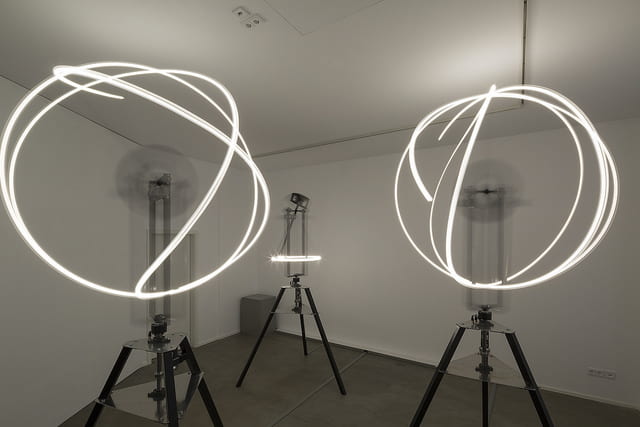 Joris Strijbos – Axon (2016)
Joris Strijbos – Axon (2016)
For Project 3 you will create a kinetic light installation / sculpture / object that incorporates both light and motion as elements of the work. The topic and form of your piece is completely open. However, your work should (1) include at least 1 form of motion and at least 1 form of light, (2) be made utilizing some digital fabrication methods and (3) be controlled by a generative composition. You should conceptually place your work in the traditions of kinetic, light, and space art as we’ve been discussing them during the semester, and you have to relate your work to the ideas of perception and abstraction as discussed in the readings.
To this end, you will first create a detailed project proposal as well as research current practitioners in the field of kinetic art and light art. After the proposal has been approved, you will have three weeks to create your project. The week before the final presentation we will have individual pre-critique sessions to ensure your project reaches its full potential. After the final presentation, you will write a detailed blog post to document the research and development of your kinetic light project. Blog post guidelines will follow.
SCHEDULE
- 04/17 – Project Proposal + Contemporary Artists Research Due (Present in Class)
- 04/21 – Legislative Day (Sunday): Work on Project
- 04/24 – Progress Update + Work on Project
- 05/01 – No Class (Labor Day): Individual pre-critiques during that week
- 05/08 – Project 3 Presentations
- 05/10 – IMA Show
- 05/15 – Project 3 Blog Post Due
PROJECT PROPOSAL
Due April 17 as a Google Slides presentation created/uploaded to this folder (filename: yourname-project3proposal), 10 minute presentation max!
Your project proposal should include the following sections:
Project Description (1 to 2 slides)
Write a two to three paragraph description of your proposed project. What is it about? What will it look like? What is it made out of? What do you want your audience to experience? What are your trying to communicate?
Perspective and Context (1 to 2 slides)
Place your project in the context of the history and current practices of kinetic, light, and space art based on what you’ve learned through the reading reflections. Reference ideas, concepts, and artistic intentions from the readings to show that you have an understanding of how to discuss your own work in a larger cultural context.
Sketches (1 to 4 slides)
Include at least one sketch of what your project will look like. Spend time on the sketch so that it clearly communicates the scope, size, and functioning of your project. Preferably, you include multiple sketches from multiple angles to convey a clearer picture of what you propose to create.
Technical Requirements (1 slide)
Make a list of all the technical requirements for your project. Include items such as lights, motors, fabrication materials, wires, fasteners, gears, axles, motor mounts, etc. Try to really think through all the elements that you will need to complete and install your project and make this list as comprehensive as possible.
Production Schedule (1 to 2 slides)
Give a week by week, or preferably day by day, breakdown of how you will build your project. Think about all the individual elements you need to create your project and which things you will need to research, purchase, order, fabricate, or invent to make what you want to make. Make realistic estimations about the time required for every step and develop your plan accordingly.
CONTEMPORARY ARTISTS RESEARCH
Due April 17 as a Google Slides presentation created/uploaded to this folder(filename: yourname-artistresearch), 10 minute presentation max!
Research the work of two contemporary artists working in kinetic / light art and create a brief presentation about their work. You will be assigned two artists from the list of Current Artists on the course site. Look into the conceptual basis of their work, their technical approaches to the creation of their projects, and any other interesting factors you can find. Include photo and video material in your presentation to convey the scope and content of the artists’ practice.
Nadine: Anila Quayyum Agha + U-Ram Choe
Snow: Zoro Feigl + Kristin McIver
Wes: Yoko Seyama + Nonotak
Charlotte: Chen Yi + Zimoun
Angy: Collectif Scale + Massimo Uberti
Santiago: Matthijs Munnik + Lumus Instruments
Ruiqi: Vincent Leroy + Breakfast Studio
Raphael: Elsemarijn Bruys + Art+Com
Xiao: 1024 Architecture + Studio Drift
Melanie: Anthony Howe + Apical Reform
Zora: Boris Acket + Si Zhuli
Ninj: Jeongmoon Choi + Olafur Eliasson
Ashley: Nicky Assmann + Isabel and Helen
Freddie: Philip Vermeulen + Lachlan Turczan
Ting: Romain Tardy + Casey Curran
Lexie: Parker Heyl + Yu Shih Fu